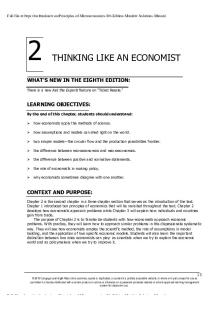Econ-HW6 - Homework assignment and great study guide for principles of microeconomics. PDF

| Title | Econ-HW6 - Homework assignment and great study guide for principles of microeconomics. |
|---|---|
| Author | Veronica Thordardottir |
| Course | Principles Of Microeconomics |
| Institution | East Carolina University |
| Pages | 3 |
| File Size | 63.3 KB |
| File Type | |
| Total Downloads | 74 |
| Total Views | 180 |
Summary
Homework assignment and great study guide for principles of microeconomics. ...
Description
ECON 2113 HW 6 Due 11/02 Multiple Choice Identify the choice that best completes the statement or answers the question. Show appropriate work where necessary.
Ch. 11—Public Goods and Common Resource D
1. A good is excludable if a. one person's use of the good diminishes another person's enjoyment of it. b. the government can regulate its availability. c. it is not a normal good. d. people can be prevented from using it.
C
2. Goods that are not excludable include both a. private goods and public goods. b. natural monopolies and common resources. c. common resources and public goods. d. private goods and natural monopolies.
A
3. When a good is rival in consumption, a. one person's use of the good diminishes another person's ability to use it. b. people can be prevented from using the good. c. no more than one person can use the good at the same time. d. everyone will be excluded from obtaining the good.
B
4. A television signal is an example of a good that is a. private. b. nonrival in consumption. c. social. d. nonexcludable in production.
B
5. Goods that are rival in consumption but not excludable would be considered a. natural monopolies. b. common resources. c. public goods. d. private goods.
D
6. Most goods in the economy are a. natural monopolies. b. common resources. c. public goods. d. private goods.
B
7. An example of a public good would be a. cable TV service. b. a tornado siren. c. clothing. d. the environment.
C
8. Which of the following is not considered a public good? a. national defense
b. basic research c. fire protection d. fighting poverty
D
9. Public goods are both a. excludable and nonrival in consumption. b. nonexcludable and rival in consumption. c. excludable and rival in consumption. d. nonexcludable and nonrival in consumption.
D
10. Which of the following would be considered a common resource? a. cable television b. bottled natural mineral water c. uncongested toll roads d. fish in the ocean
B
11. Goods that are both nonexcludable and rival in consumption would be considered a. natural monopolies. b. common resources. c. public goods. d. private goods.
C
12. Which of the following goods is rival and not excludable? a. national defense b. cable TV service c. lobsters in the ocean d. a boat
A
13. An example of a natural monopoly would be a. cable TV service. b. a tornado siren. c. clothing. d. the environment.
B
14. A free rider is a person who a. will only purchase a product on sale. b. receives the benefit of a good but avoids paying for it. c. can produce a good at no cost. d. takes advantage of tax loop-holes to lower his taxes.
C
15. Which of the following is an example of a public good? a. a candy bar b. a painting by Monet c. a beautiful sunset d. a crowded beach
C
16. The Tragedy of the Commons a. occurs most often with public goods. b. is only applicable to shared grazing rights among sheep herders. c. is eliminated when property rights are assigned to individuals. d. occurs when social incentives are in line with private incentives....
Similar Free PDFs

Principles of microeconomics HW1
- 10 Pages

Microeconomics Final Study Guide
- 23 Pages

5 Principles of Great Management
- 3 Pages
Popular Institutions
- Tinajero National High School - Annex
- Politeknik Caltex Riau
- Yokohama City University
- SGT University
- University of Al-Qadisiyah
- Divine Word College of Vigan
- Techniek College Rotterdam
- Universidade de Santiago
- Universiti Teknologi MARA Cawangan Johor Kampus Pasir Gudang
- Poltekkes Kemenkes Yogyakarta
- Baguio City National High School
- Colegio san marcos
- preparatoria uno
- Centro de Bachillerato Tecnológico Industrial y de Servicios No. 107
- Dalian Maritime University
- Quang Trung Secondary School
- Colegio Tecnológico en Informática
- Corporación Regional de Educación Superior
- Grupo CEDVA
- Dar Al Uloom University
- Centro de Estudios Preuniversitarios de la Universidad Nacional de Ingeniería
- 上智大学
- Aakash International School, Nuna Majara
- San Felipe Neri Catholic School
- Kang Chiao International School - New Taipei City
- Misamis Occidental National High School
- Institución Educativa Escuela Normal Juan Ladrilleros
- Kolehiyo ng Pantukan
- Batanes State College
- Instituto Continental
- Sekolah Menengah Kejuruan Kesehatan Kaltara (Tarakan)
- Colegio de La Inmaculada Concepcion - Cebu












